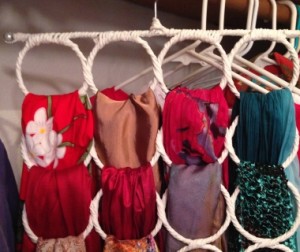 There are a lot of ways to store a scarf; and most of them are fine for your typical run-of-the-mill scarf. But there are scarves, and there are scarves… And some scarves can handle just about anything, while others cannot handle even one thing.
There are a lot of ways to store a scarf; and most of them are fine for your typical run-of-the-mill scarf. But there are scarves, and there are scarves… And some scarves can handle just about anything, while others cannot handle even one thing.
There are the brilliant and fun squares of color that we find at the local department store for ten to twenty dollars – made of rayon, polyester, acrylic or any one of what seem now to be hundreds of ‘blends’ – the new form of man-made synthetic fabric that is easy-care, easy-maintenance and no-worry. These fabrics are easy to store – on hangers, in ring hangers like the EZ Scarf Swivel Hanger or pretty much however you’d like to store them.
Then there are the woolens. These can be the cashmere, pashmina, lambs wool, knitted or woven, thick or light and fine, whichever way they come, these too are pretty forgiving. They store very well on rings and when put away for long term or off season storage should be protected in an opaque (light blocking) garment bag and with a sachet of lavender or lavender cedar blend or with a cedar block to repell clothes moths. Sachets can be found here: http://www.preservesmart.com/products.htm.
Next are the satins and sateens. Smooth and slippery with a single or double sided shine, these scarves are often dramatic in their coloring and beautiful to the touch. They are slippery and so any ring or hanger needs to be somewhat non-slip. Uncovered plastic, wood and metal may be too slick to hold them in place. They are also fairly durable and generally do not have any problem with snagging or catching. When made from cotton or silk they will need the same protection as woolens if stored to prevent damage by moths and sunlight.
Then come the designer scarves – the silks, and silk and cashmere blends – and the ultra fine scarves. These are the Hermès Carré scarves, the Alexander McQueen’s, and the Louis Vuitton’s… Their high end price tag is the first warning that they are not to be toyed with. But also that they need special care. The Hermès silk squares, called Hermès Carré scarves were first introduced in 1937 and have been a collector’s item ever since.
First, if you own this sort of scarf, you clearly have the means to take good care of it; and second, if you don’t then the scarf could pay for you to solve your short term financial problems. But either way, such a scarf belongs in a linen or cardboard box, with acid free tissue around them (find it here) and folded loosely without creases. It can be hung, to be sure, but only on a simple hook or perhaps a leather loop. Never on anything that can possibly grab the fabric and cause a snag. And be sure, these scarves, for all their high end pricetag and beauty, do snag. The Louis Vuitton over-sized leopard print cashmere and silk scarf, which measures a generous 92 inches by 109 inches, is notorious for snagging. And the Hermès Carrés of silk in brilliant custom designed patterns are famous for running if they get wet. So, they may be high end, but they are also high maintenance.
These high-end designer scarves are not the scarves the EZ Scarf hanger was made for. In fact, there is probably no scarf hanger in the world which could or should be made for them.
Never store natural fabrics in plastic wraps or sealed in plastics. They need to breathe, and air circulation is important. Garment bags which are open slightly at the top can work well, especially if a good quality sachet is used. If using plastic hanging garment bags with pockets for shelves for fine scarves, wrap the scarves in acid free tissue paper before slipping them into the slots. The best answer for scarves of this calibre are probably small linen zip up box containers or the boxes they came in. Tissue paper is also helpful for keeping them crease-free in their boxes. Make sure the tissue is acid free to avoid discoloration caused by the acid in the paper. If you are storing white scarves use a blue acid free tissue paper to preserve the white color.

